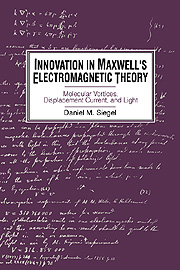Book contents
- Frontmatter
- Contents
- Preface
- Introduction
- 1 The background to Maxwell's electromagnetic theory
- 2 Mechanical image and reality in Maxwell's electromagnetic theory
- 3 The elaboration of the molecular-vortex model
- 4 The introduction of the displacement current
- 5 The origin of the electromagnetic theory of light
- 6 Beyond molecular vortices
- Conclusion
- Appendix 1 Draft of “On Physical Lines of Force,” a fragment
- Appendix 2 Drafts of “A Dynamical Theory of the Electromagnetic Field”
- Appendix 3 Vortex rotations in a curl-free region
- Notes
- Index
Appendix 1 - Draft of “On Physical Lines of Force,” a fragment
Published online by Cambridge University Press: 24 October 2009
- Frontmatter
- Contents
- Preface
- Introduction
- 1 The background to Maxwell's electromagnetic theory
- 2 Mechanical image and reality in Maxwell's electromagnetic theory
- 3 The elaboration of the molecular-vortex model
- 4 The introduction of the displacement current
- 5 The origin of the electromagnetic theory of light
- 6 Beyond molecular vortices
- Conclusion
- Appendix 1 Draft of “On Physical Lines of Force,” a fragment
- Appendix 2 Drafts of “A Dynamical Theory of the Electromagnetic Field”
- Appendix 3 Vortex rotations in a curl-free region
- Notes
- Index
Summary
Few working papers survive from the period when Maxwell was working on “Physical Lines.” My own search of relevant archives, as well as the more exhaustive search conducted by Peter Harman in connection with his edition in progress of The Scientific Letters and Papers of James Clerk Maxwell, 3 vols. (Cambridge University Press, 1990–), turned up nothing beyond the material to which attention is directed by A. E. B. Owens's handlist to Add. MSS 7655 at the University Library, Cambridge. Of a set of five folios constituting Add. MSS 7655, V, c/8, two folios clearly correspond to the period when Maxwell was working on “Dynamical Theory” (see Appendix 2), and a third, dealing with “Helmholtz's Wirbelfäden [Vortex Filaments],” appears to date from a later period as well (1864–70 – Peter Harman, private communication; see also Letters and Papers of Maxwell, 2). The two remaining folios (both blank verso) evidently are associated with “Physical Lines.” One of these clearly relates to the treatment of motional electromotive forces that appears in “Physical Lines,” Part II, 476–85; this draft fragment refers explicitly to “equations (55),” which appear on p. 476 of the published version, and arrives at a form of the published equations (77), on p. 482.
The remaining folio is quite informative concerning various aspects of Maxwell's work on the molecular-vortex model; a photograph of it is presented in Fig. A 1.1, and I here transcribe it in full (cf. also the transcription in Harman, ed., Letters and Papers of Maxwell, 1 693).
- Type
- Chapter
- Information
- Innovation in Maxwell's Electromagnetic TheoryMolecular Vortices, Displacement Current, and Light, pp. 174 - 179Publisher: Cambridge University PressPrint publication year: 1992



